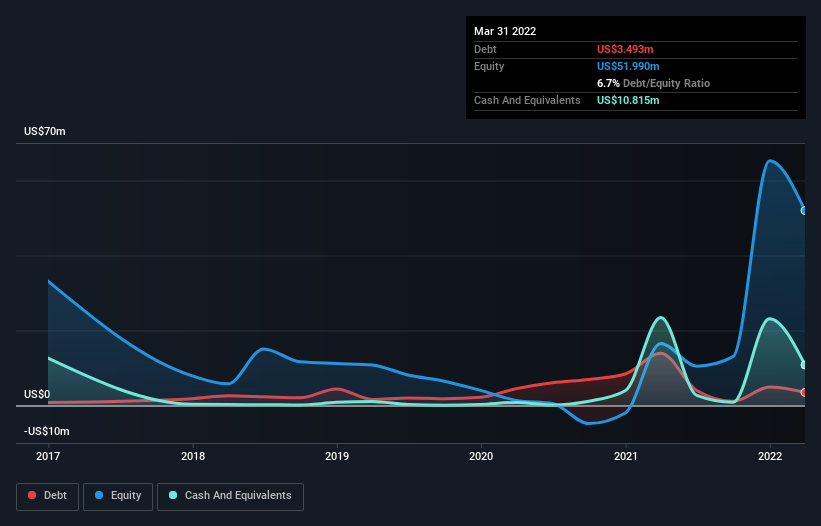
Some say volatility, rather than debt, is the best way to think about risk as an investor, but Warren Buffett famously said that 'Volatility is far from synonymous with risk.' So it might be obvious that you need to consider debt, when you think about how risky any given stock is, because too much debt can sink a company. As with many other companies Phunware, Inc. (NASDAQ:PHUN) makes use of debt. But the real question is whether this debt is making the company risky.
Why Does Debt Bring Risk?
Debt assists a business until the business has trouble paying it off, either with new capital or with free cash flow. If things get really bad, the lenders can take control of the business. However, a more usual (but still expensive) situation is where a company must dilute shareholders at a cheap share price simply to get debt under control. Of course, the upside of debt is that it often represents cheap capital, especially when it replaces dilution in a company with the ability to reinvest at high rates of return. The first step when considering a company's debt levels is to consider its cash and debt together.
View our latest analysis for Phunware
How Much Debt Does Phunware Carry?
As you can see below, Phunware had US$3.49m of debt at March 2022, down from US$13.9m a year prior. But it also has US$10.8m in cash to offset that, meaning it has US$7.32m net cash.

How Healthy Is Phunware's Balance Sheet?
According to the last reported balance sheet, Phunware had liabilities of US$26.1m due within 12 months, and liabilities of US$3.31m due beyond 12 months. Offsetting this, it had US$10.8m in cash and US$1.22m in receivables that were due within 12 months. So its liabilities outweigh the sum of its cash and (near-term) receivables by US$17.4m.
Of course, Phunware has a market capitalization of US$102.7m, so these liabilities are probably manageable. However, we do think it is worth keeping an eye on its balance sheet strength, as it may change over time. While it does have liabilities worth noting, Phunware also has more cash than debt, so we're pretty confident it can manage its debt safely. When analysing debt levels, the balance sheet is the obvious place to start. But ultimately the future profitability of the business will decide if Phunware can strengthen its balance sheet over time. So if you want to see what the professionals think, you might find this free report on analyst profit forecasts to be interesting.
Over 12 months, Phunware reported revenue of US$16m, which is a gain of 75%, although it did not report any earnings before interest and tax. Shareholders probably have their fingers crossed that it can grow its way to profits.
So How Risky Is Phunware?
We have no doubt that loss making companies are, in general, riskier than profitable ones. And the fact is that over the last twelve months Phunware lost money at the earnings before interest and tax (EBIT) line. Indeed, in that time it burnt through US$25m of cash and made a loss of US$54m. Given it only has net cash of US$7.32m, the company may need to raise more capital if it doesn't reach break-even soon. Phunware's revenue growth shone bright over the last year, so it may well be in a position to turn a profit in due course. Pre-profit companies are often risky, but they can also offer great rewards. The balance sheet is clearly the area to focus on when you are analysing debt. But ultimately, every company can contain risks that exist outside of the balance sheet. We've identified 4 warning signs with Phunware , and understanding them should be part of your investment process.
If you're interested in investing in businesses that can grow profits without the burden of debt, then check out this free list of growing businesses that have net cash on the balance sheet.
New: Manage All Your Stock Portfolios in One Place
We've created the ultimate portfolio companion for stock investors, and it's free.
• Connect an unlimited number of Portfolios and see your total in one currency
• Be alerted to new Warning Signs or Risks via email or mobile
• Track the Fair Value of your stocks
Have feedback on this article? Concerned about the content? Get in touch with us directly. Alternatively, email editorial-team (at) simplywallst.com.
This article by Simply Wall St is general in nature. We provide commentary based on historical data and analyst forecasts only using an unbiased methodology and our articles are not intended to be financial advice. It does not constitute a recommendation to buy or sell any stock, and does not take account of your objectives, or your financial situation. We aim to bring you long-term focused analysis driven by fundamental data. Note that our analysis may not factor in the latest price-sensitive company announcements or qualitative material. Simply Wall St has no position in any stocks mentioned.
About NasdaqCM:PHUN
Phunware
Provides integrated software platform that equips companies with the products, solutions, and services to engage, manage, and monetize their mobile application portfolios in the United States and internationally.
Flawless balance sheet moderate.

